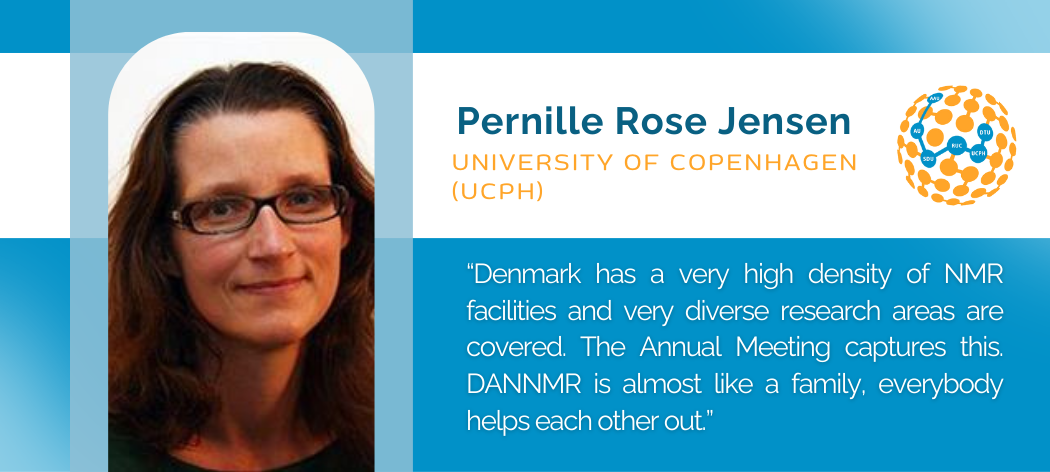Antibiotic resistance has become an increasingly prevalent problem in the world today and new methods must be developed to solve this issue. The emergence of advanced NMR techniques has aided in investigating the reasons for this resistance and could potentially help to develop new solutions. Pernille Rose Jensen is a group leader in HYPERMAG at DTU, where she investigates bacteria with d-DNP, a promising technique for cellular studies. Here she attempts to identify new drug targets and methods for preventing antibiotic resistance.
Pernille Rose Jensen undertook her PhD studies at UCPH supervised by Flemming Poulsen, focusing on using NMR spectroscopy to study proteins and their dynamics. After finishing her PhD, she travelled to Basel in Switzerland for Post Doc position still focusing on protein NMR spectroscopy.
When she returned to Denmark a couple of years later, she founded Albeda Research Aps. together with Mathilde Hauge Lerche and Magnus Karlsson, a company which specialized in MRI of hyperpolarized substances. When their group was invited to participate in establishing the basic research center HYPERMAG, founded by Jan Henrik Ardenkjær-Larsen at DTU, she transitioned there. At DTU she continues her research within hyperpolarization in relation to magnetic resonance.
The overall aim for the HYPERMAG center is to identify metabolic biomarkers and translate them to the clinic. This is an interdisciplinary task which requires collaboration between hardware engineers, microbiologists, chemist, physicists, MR physicists and NMR spectroscopists.
Advanced NMR methods for understanding complex systems
Advanced methods are needed to gain insight into complex molecular systems such as living cells. NMR stands out as a critical analytical technique, thanks to its low-energy, nondestructive nature, and its capability to elucidate functions and dynamics of the cells and their components. However traditional NMR techniques often lack the sensitivity to study living cell metabolism.
Hyperpolarization is a technique where the distribution of nuclear magnetism is temporarily increased, and this directly increases the signal-to-noise ratio in NMR spectroscopy. Dissolution dynamic nuclear polarization (dDNP) is the most versatile hyperpolarization technique and the one used in HYPERMAG. The method allows the researchers to detect and enhance the NMR signal temporarily by more than a factor of ten thousand.
In dDNP hyperpolarized substrates are generated ex situ in a dedicated instrument (a polarizer), that is outside the cell and outside the NMR spectrometer. The substrate is then mixed and analyzed with a cell culture placed in an NMR spectrometer or an animal in an MRI scanner. Due to the vast signal enhancement this essentially allows metabolism to be detected without background.
Hyperpolarization offers real-time molecular tracking within living cells, illuminating cellular functions unobservable through other means, one example is the visualization of metabolic pathways and reaction networks including glycolysis. This provides some rather unique insights into the function and dysfunctions of organisms.
The HYPERMAG lab hosts three hyperpolarization instruments and two NMR spectrometers. These instruments undergo continuous innovation, such as attempts to minimize helium consumption, a concern given the global helium shortage. The transfer speed of the hyperpolarized sample is crucial; hence, rapid transport systems have been implemented in the lab.
Bacterial pathogens
The treatment and understanding of bacterial pathogens can potentially benefit from the development of hyperpolarization techniques, and it is one of Pernille’s research areas.
One disease Pernille has investigated is Shigellosis, an important foodborne illness caused by the bacteria Shigella. Shigella has still not been investigated thoroughly due to lack of effective techniques and little is known about the metabolic interaction between Shigella and the host cells during the stages of infection. One of the key findings has been a process related to formate metabolism, which is very sensitive to the different environments Shigella encounters during the infection process. Formate metabolism is particularly interesting because it has been recognized as a potential drug target since it is only found in microorganisms like Shigella and not in humans.
Antibiotic-resistant bacteria have been a growing concern for the last decade, and with antibiotics becoming less effective over time, new and sustainable treatments are needed. Bacterial metabolism adapts upon treatment with antibiotics to escape cell death and in recent years a close link between bacterial metabolism and antimicrobial drug action has become clear. Pernille study how bacterial metabolism changes when bacteria susceptible to antibiotic treatment evolves into antibiotic resistant bacteria and she tries to understand if these metabolic changes can be used to re-sensitize antibiotic resistant bacteria to known drugs or potentially pave the way for new targets.
Strength of Danish NMR
“Despite being such a small country, we have a very high density of NMR facilities and very diverse research areas are covered. I am always amazed when I see how many different topics can be studied by placing samples ranging from concretes to humans in a magnetic field. The yearly Danish NMR meeting captures this diversity but still manage to bring us together driven by the ambition to solve new scientific challenges with our technique. The Danish NMR community is almost like a family, everybody helps each other out.” Pernille explains.
Written by: Jonatan Emil Svendsen


Very interesting information!Perfect just what I was looking for!Raise your business
ремонтный сервис apple